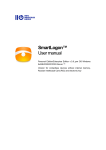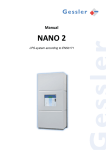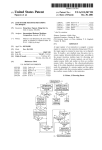Download the manual
Transcript
User Manual Version 1.2 Date: July 2011 Table of Contents 1 Instructions 3 1.1 Fingerprint Placement. . . . . . . . . . . . .3 1.2 Instruction for Card Swipe. . . . . . . . . . . 3 1.3 Precautions. . . . . . . . . . . . . . . . . 3 2 Introduction of device 4 2.1 Overview of Device Functions . . . . . . . . . 4 2.2 Product Appearance . . . . . . . . . . . . .4 2.3 Use of External USB Keyboard . . . . . . . . . 5 2.4 Verification State . . . . . . . . . . . . . . 6 2.5 Management Card (M-card) . . . . . . . . . 6 2.6 System Password. . . . . . . . . . . . . . . 7 2.7 Operation Timeout. . . . . . . . . . . . . . 7 3 Device Operations 7 3.1 Management Card. . . . . . . . . . . . . . 7 3.1.1 Enrol a Management Card. . . . . . . . . 7 3.1.2 Enrol an Ordinary User . . . . . . . . . . . 8 3.1.3 Enrol Card & Fingerprint(add users). . . . . 10 3.1.4 Delete a Single User . . . . . . . . . . . 11 3.2 USB Keyboard Operation. . . . . . . . . . . 12 3.2.1 Set Keyboard Password. . . . . . . . . . 13 3.2.2 Enrol a User Through Keyboard . . . . . . . 13 3.2.3 Delete a Specific User . . . . . . . . . . 15 3.2.4 Delete All Users . . . . . . . . . . . . . 16 3.2.5 Restore Factory Defaults . . . . . . . . . 16 3.3 Access Control Function. . . . . . . . . . . 16 3.3.1 Access Control Functions. . . . . . . . . 17 3.4 User Verification . . . . . . . . . . . . . . . 18 3.5 U-disk. . . . . . . . . . . . . . . . . . . 20 3.6 Tamper Switch. . . . . . . . . . . . . . . 21 4 Appendix Appendix A . . . . . . . . . . . . . . . . . . List of parameters . . . . . . . . . . . . . . Appendix B . . . . . . . . . . . . . . . . . . Wiring diagram : power & comms . . . . . . . . Appendix C . . . . . . . . . . . . . . . . . . Wiring diagram : Normal Open & Close . . . . . 21 21 21 22 22 23 23 2 1. Intructions Summary Recommended fingers: The index finger, middle finger or the ring finger; the thumb and little finger are not recommended (because they are usually clumsy on the fingerprint collection screen). * Please ensure a correct placement of finger on reader. 1.1 Fingerprint Placement Please enrol and verify your fingerprint by using the proper finger placement mode. We shall not be held accountable for any consequences arising out of the degradation in verification performance due to improper user operations. We shall reserve the right of final interpretation and revision of this document. 1.2 Instruction for Card Swipe This device is supplied with an integrated non-contact RFID (125 MHz) card reader module. By offering multiple verification modes such as fingerprint, RF card and fingerprint + RF card verification, this device can accommodate diversified user needs. Swipe your card across the sensor area after the voice prompt and remove your card after the device has sensed it. For the swipe area, please see 2.2 Product Appearance. * RFID Card * Don’t install in direct sunlight * Bright light 1.3 Precautions Protect the device from direct sunlight or bright light, this greatly affects the fingerprint collection and leads to a fingerprint verification failure. It is recommended to use the device under a temperature of 0–50°C so as to achieve the optimal performance. In the event of exposure of the device to the outdoors for long periods of time, it is recommended to adopt sunshade and heat dissipation facilities because excessively high or low temperature may slow down the device operation and result in high false rejection rate (FRR). When installing the device, please connect the power cable after connecting other cables. If the device does not operate properly, be sure to shut down the power supply before performing necessary inspections. Note that any live-line working may cause damage to the device and the device damage arising out of live-line working falls beyond the scope of our normal warranty. For matters that are not covered in this document, please refer to related materials including the installation guide, access control software user manual. 3 * Temp 0 - 50°C * Connect all cables before connecting the power cable. * Power down unit when doing maintenance 2. Introduction of Device Summary 2.1 Overview of Device Functions As an integrated fingerprint & access control device, our product can be connected with either an electronic lock or an access controller. This device features simple and flexible operations and supports the use of management cards. With a management card, you can perform such functions as offline enrolment, deletion and U-disk management. The voice prompts will guide you through all the operations without screen display. This device allows you to connect an external keyboard and offers multiple operation modes. It supports access control function for a security management. It supports multiple communication modes. The U-disk features simple and convenient operations. Featuring a compact and simple design, this device allows users to connect several devices through a PC and perform real-time monitoring. * Can be connected to electronic lock or access controller * Use management card to enroll / delete users * U-disk compatible for up & download of users * Diagram for connection possibilities 2.2 Product Appearance Front view: * Important areas on the ZK 54. • • • LED indicator: The LED indicator is used to display device operation results and exceptional statuses which are defined as follows: Common rules: If an operation succeeds, the green indicator will illuminate solid for one second; otherwise, the red indicator will illuminate for one second. Enrolment state: The green LED blinks three times, every three seconds. • Single user deletion: The red LED blinks three times every three seconds. • Verification state: The green LED blinks once every two seconds. • Card Swipe area: Refers to the area in the red dashed-line box shown in the figure above. • FP sensor: Used to collect and match fingerprints and delete users. 4 * Take note of LED indicator dislays, for ease of use. * Take note of card swipe area Summary Bottom view: * Take note of USB port & reset switch • USB interface: Used to connect with a U-disk or a keyboard. • Reset button: Used to restart the device. • Speaker: Used to play the BEEP sound and voice prompts. If a user passes the verification, the speaker beeps once; if the user fails to pass the verification, the speaker beeps twice. The default prompts during operation: beep + voice prompts. Rear View: * Diagram for wiring & DIP switch • Wiring terminal: Connects with locks and power supply through cables. * DIP switch setting: • TCP/IP: The TCP/IP interface connects with a PC through a network cable (for detailed connection, please see the installation guide.) ** Four pins 1,2,3 & 4 • Tamper Switch: Used to generate a tamper alarm. For details, please see 3.6 Tamper switch) • DIP Switch: The DIP switch has four pins numbered 1, 2, 3 and 4. In the RS485 communication mode, the first 1, 2 and 3 pins are used to set hardware device number and the fourth pin is used to select the status of terminal resistance. For detailed settings, please see the installation guide. *** Pins 1,2 & 3 - set hardware device number *** Pin 4 - Select the status of terminal resistance. 2.3 Use of an External USB Keyboard To facilitate device operations, you can connect the device with an external USB keyboard (purchased by users) and conveniently perform such operations as user enrolment, deletion and restoring factory defaults, especially when specifying user ID’s during user enrolment and deletion. 5 * USB keyboard can also be used to enrol / delete users. Summary USB Keyboard: * USB Keyboard layout /ESC * NUMLOCK is numeric keypad toggle. * When connected only use : An external USB keyboard is shown above (please refer to the actual product): **Numeric keys NumLock is a numeric keypad toggle key. It is activated by default. If it is activated, the LED indicator is on. When the device is connected with an external keyboard, you can only use the numerical keys, “Backspace” key and “Enter” key in the NumLock activated state. **Backspace **ENTER key 2.4 Verification State Verification state: After the device is powered on, it will enter the verification state if a management card has been enrolled before, or returns from other states. * Default state after enrolment have been done. In the verification state, all users are allowed to verify their identities and unlock the door (the administrator bearing a management card can only unlock the door by using his/ her fingerprint(s) previously enrolled); the administrator can perform such operations as user enrolment/deletion, U-disk management and keyboard operation. 2.5 Management Card (M-card) The device users are classified into administrators and ordinary users. Administrators: An administrator is allowed to perform all operations including user enrolment/deletion (deleting all the other users except himself/herself) and U-disk management. The privileges of the device administrators are implemented through the management cards. Ordinary users: Ordinary users are only allowed to verify their identities and unlock thedoor. A management card is a card specially allocated for an administrator. Each device must at least enrol one management card. If no management card is enrolled, you cannot perform any operation and the system will generate a voice prompt “ : Please register the management card”. You can implement different functions by swiping a management card for different times in a row: • No U-disk or external keyboard is connected: • By swiping the management card once, you can go into the single user enrol ment state. • By swiping the management card five times in a row, you can enter the single user deletion state. • U-disk is connected: • • An external keyboard is connected: • By swiping the management card once, you can go into the U-disk manage ment state. By swiping the management card once, you can activate the external key board. * Administartor have full access to system menu * Users can only verify ID and unlock * Swipe M-card once - user enroll. * Swipe M-card 5 times user deletion mode. * Swipe M-card once to manage U-disk * Swipe M-card once for keyboard usage. 6 Consecutive swipes: Consecutive swipes means the interval between two swipes in a row is less than 5 seconds. Summary The management cards can be deleted through the “Clear All” function of the keyboard, or have their administrative privileges cleared through software before they are deleted as ordinary ID Cards. For details, please see the access control software user manual. * Less than 5 seconds between consecutive swipes. The FP of administrator (the one who possesses management card) can be enrolled through software or keyboard enrolment. * M-card can be deleted via “Clear All” function or through software. A device without a management card: if you have the keyboard password, you can activate the external keyboard and enrol/delete users. Note: Users who bear management cards can only verify their identity and unlock using their finger prints previously enrolled. 2.6 System Password The system password is a password used to enhance the security of device data in TCP/ IP or RS485 communications. * System password set up through access control software. Note: The system password can be modified through the access control software. For details, please see the access control software user manual. 2.7 Operation Timeout There are 30 seconds before operation times out. The voice will notify you every 10 seconds for 3 times if there is no appropriate operation. After this 30 seconds, the system will return to verification state with voice prompt “ : Operation timeout. The system returns to verification state”. * Default time out 30 seconds * 3 voice prompts to warnining Note: You can set the timeout time through the access control software. 3. Device Operations 3.1 Management Card 3.1.1 Enrol a Management Card To enrol a management card, please proceed as follows: * Take note of steps on how to enrol a M-card. 1. The device can automatically detects whether a management card exists. 2. If the device fails to detect the presence of the management card, it will enter the management card enrolment state. Then proceed with step 3; otherwise the system generates the voice prompt “ : Verify users. Please press your finger or punch your card”. ** System auto detects 3. After the system generates the voice prompt “ : Please register the management card”, you can swipe your card across the sensor area. ** Swipe card 4. If enrolment fails, the system generates the voice prompt “ : The card number is repeated” and returns to step 3; if enrolment succeeds, the system generates the voice prompt “ : Registration is successful. The system returns to verification state”. Note: The system returns to the verification state if any operation in step 3 times out and only prompts you to enrol the management card after you restart the device again. 7 ** Failure of detect: system enters M-card management state ** Registration complete Summary Management card enrolment flow chart as shown below: System Power-on Please register the management card Does M –card exist ? Verify users. Please press your finger or punch your card. YES Verification State The card number is repeated. NO Swipe card * Please follow the steps and voice prompts as shown on the left for MCard enrolment NO YES Enrol a M-card Registration is successful. The system returns to the verification state. Return to verification state 3.1.2 Enrol an Ordinary User The mode for you to enter the enrolment state by using the management card is called the management card enrolment mode. In this mode, you can only enrol one user. When you enrol a new user, the system automatically assigns a minimum idle ID to the user. Furthermore, you can also use the external keyboard enrolment mode (For details, please see 3.2.2 Enrol a User with Keyboard) to implement user enrolment of specific ID. * Management card enrolment mode * 10x fingerprints per user and 1 RFID card In both these two enrolment modes, you can enrol new users. Each user is allowed to enrol 10 fingerprints and one ID card at most. To enrol a user, proceed as follows: 1. In the verification state, the system goes into the ordinary user enrolment state after you swipe a management card once (In the enrolment state, swiping a management card once will return the device to the verification state). 2. After the system generates the voice prompt “ : Register users. Please press your finger or punch your card”, you can start user enrolment. There are the following three cases: 8 * Verification state - M-card swiped once - enrol user * Enrolment state - M-card swiped once - return to verification mode * Follow voice prompts Summary 1. Swipe ID card first • When you swipe your new ID card and succeed in enrolling a user, the device will generate a voice prompt “ : User number **. Registration is successful!” (** refers to the ID that is automatically assigned to the user by the system; same below) and you can proceed to the next step; if you swipe an enrolled ID card, the system generates the voice prompt “ : User number **, Register. Please press your finger!” and enter the specified user enrolment state. * Please follow the steps and voice prompts as shown on the left. • After the device generates the voice prompt “ : Register. Please press your finger”, the system enters the specific fingerprint enrolment state. Press the same finger on the sensor three times following the voice prompts. * Press finger three times follow the prompts. • If fingerprint enrolment succeeds, the system generates the voice prompt “ : Registration is successful. Register. Please press your finger” and directly enters the next fingerprint enrolment state; if fingerprint enrolment fails, the system generates the voice prompt “ : The fingerprint is repeated” and repeats previous step. * If registration fails, it will return to registeation mode to proceed again. • The system automatically returns to the verification state when all 10 fingers and ID card are enrolled, or the management card is swiped once or operation times out. 2. Press finger first • Press the same finger over the sensor three times following the voice prompts by adopting the proper fingerprint placement. If fingerprint enrolment succeeds, the system generates the voice prompt “ : User number **. Registration is successful” and you can proceed to step b; if the fingerprint has enrolled before, the system generates the voice prompt “ : User number **, Register, Please press your finger or punch your card” and enter the specified user enrolment state. • After generating the voice prompt “ : Register. Please press your finger or punch your card”, the system enters the specified user information enrolment state, waiting for you to swipe your new ID card or press your finger. • If the ID card enrolment succeeds, the system generates the voice prompt “ : Registration is successful. Please press your finger” and enters the fingerprint enrolment state directly; if you press a finger that is not enrolled before and succeeds in enrolment of this finger, the system generates the voice prompt: “ : Registration is successful. Please press your finger or punch your card” and you can continue enrolling new fingerprints and card. After you enrol 10 fingerprints, the system will generate the voice prompt “ : Please punch your card” to enrol your ID card if your ID card is not enrolled. • The system automatically returns to the verification state when both 10 fingers and ID card are enrolled, or the management card is swiped once or operation times out. 3. If you are already assigned with a user number: • Enrol fingerprint(s) when you have already enrolled card • After you swipe the enroled card, the system will generate the voice prompt “ : User number **. Register. Please press your finger” (** refers to the ID as signed to you; same below) and enter the fingerprint enrolment state. • Press the same finger over the sensor three times following the voice prompts by adopting the proper fingerprint placement. If fingerprint enrolment succeeds, the system generates the voice prompt “ : User number **. Registration is suc cessful” and gets ready for enrolment of next fingerprint. • The system automatically returns to the verification state when both 10 fingers and ID card are enrolled, or the management card is swiped once or opera tion times out. * System will return to verification state, when 10 fingers and card are enroled, or M-card is swiped. * Press same finger three times to enrol. * User can enrol 10 fingers, and then card. * M-card can stop the process by swiping the card. * Follow the steps for how to enrol a fingerprint after a card. Note: The fingerprint of administrator can not be enrolled by this mode * If user re-enrols a finger, it will overwrite previous finger. 9 Summary 3.1.3 Enroll Card and Fingerprint(s) when you have already enrolled fingerprint(s) • Press the finger with fingerprint already enrolled three times following the voice prompts. If you are identified as the same person in each of verification attempts, the system enters the fingerprint enrolment state. • After generating the voice prompt “ : User number **. Register. Please press your finger or punch your card”, the system will start to enroll your fingerprint. • If the ID card enrolment succeeds, the system generates the voice prompt “ : Registration is successful. Register. Please press your finger” and will enter the ingerprint enrolment state directly; if you press a finger that is not enrolled before and succeeds in enrolment of this finger, the system generates the voice prompt: “ : Registration is successful. Please press your finger or punch your card” and you can continue enrolling new fingerprints or card. After you have enrolled 10 fingerprints, the system will generate the voice prompt “ : Please punch your card” to enrol your ID card. • * Bearer of M-card can’t enrol fingerprint. * Press finger three times follow the prompts. * Follow voie prompts. The system will automatically return to the verification state when all 10 fingers and ID card are enrolled, or the management card is swiped once or operation times out. * After 10 fingers system returns to verification state Enrolment state Number of user is full Register users. Please press your finger or punch your card The card number is repeated. YES Return to the verification state NO NO User number **. Register. Please press your finger. Press finger or swipe card * Process flow chart Please punch Please punch your card again your card again YES New fingerprint or card? Register. Please press your finger or punch your card. YES Is new user enrolment successful? NO The number of The number of enrolled enrolledusers usersisisfull./ full. /The Thecard cardhas hasbeen been registered/ thecard card registered/ the number is repeated number is repeated NO Registration Registration is successful is successful YES Swipe card Press finger Card enrolment successful ? Is finger enrolment successful? NO Are 10 fingers and card enrolled? The system returns to verification state YES User registration successful NO YES Enrolment is successful NO The number enrolled fingerprints is full / The fingerprint is repeated Return to verification state 10 3.1.4 Delete a Single User Summary Deleting a user by using a management card is called the simple single-user deletion mode. Deleting a user by using an external keyboard is called the specified user deletion mode. (See 3.2.3 Delete a Specified User). * Delete user with card single mode The operation steps for simple single-user deletion: • In verification state, swipe your management card for five consecutive times to enter the simple single-user deletion state (swipe your card one more time to return to the verification state). * Delete user with keyboard - spicified mode * Swipe card 5 times. • The system will generate the voice prompt “ ger or punch your card.” • Press your finger onto the fingerprint sensor or swipe your card over the card reader. • • • • • If you swipe your management card one more time or your operation times out, the system will return to the verification state. : Delete users. Please press your fin- Press your finger onto the sensor to delete a user. Press one of your enrolled fingers properly onto the sensor. If the verifi cation succeeds, the system will generate the voice prompt “ : User number **. Deletion is successful. Delete users. Please press your finger or punch your card.” (**indicates the ID number of the user) and automatically return to the deletion state. If the verification fails, the system will generate the voice prompt “ : Please press your again.” * Process Swipe your card over the reader to delete a user. Swipe a registered card over the reader. If the verification succeeds, the system will generate the voice prompt “ : User number **. De letion is successful. Delete users. Please press your finger or punch your card.” and automatically return to the deletion state. If the verifica tion fails, the system will generate the voice prompt “ : Please punch your card again.” Note: In simple single-user deletion mode, management cards cannot be deleted because swiping the management card will return the system to the verifica tion state. 11 * Single delete mode, management can’t be deleted Summary Delete a Single User flow chart Verification state * Single user delete process Enter the deletion state after swiping the M-card 5 times in a row Delete users. Press your finger or punch your card. Card verification Fingerprint verification Is card verification successful? Is fingerprint verification successful? Please punch your card again. NO YES NO YES Please press your finger again Please try again User number **. Delete successful. Delete User Return to the verification state after M-card is swiped once or operation is timed out 3.2 USB Keyboard Operation Keyboard operation flow chart * Keyboard operation Process Verification state Password + Enter 1 + Enter 2 + Enter 3 + Enter + 3 + Enter 9 + Enter + 9 Enter 8 + Enter + 8 + Enter Enrolment state Single user deletion Restore factory defaults Delete all Enter Password Return to verification state NO Return to verification state Return to verification state Return to verification state Return to verification state 12 Summary 3.2.1 Set Keyboard Password If the user needs an external keyboard, he/she can connect the keyboard to the device and then swipe the management card to activate the external keyboard. The system enables the user to set a dedicated password for the external keyboard. * Plug in keyboard and swipe M-card to activate Operation steps: • In verification state, connect an external keyboard with the device through the USB interface. • Swipe your management card once to activate the keyboard. The system generates the voice prompt “ : Please press the keyboard.” • Type in “8” and press “Enter”. Then type in “8” and press “Enter” again. The system generates the voice prompt “ : Please set password.” Type in your desired password and press “Enter”. The system generates the voice prompt “ : The operation is successful. The system returns to verification state.” If there are no keystrokes within 30 seconds, the system will generate the voice prompt “ : Operation timeout. The system returns to verification state.” (The password must be between 4 and 6 digits) • The user can enter this password to activate the functions of the external keyboard for further use, or swipe a management card once (which is mandatory for the first use of the external keyboard). 1. If you enter a wrong password for six consecutive times, the keyboard will be locked and you will have to power on the keyboard again to unlock it. * 8 + Enter + 8 + Enter * Timeout after 30 seconds if no action is taken. * Password must be between 4 and 6 digits * Please take note !! 2. If there are no keystrokes within 30 seconds after the keyboard is activated, the keyboard functions will be automatically deactivated. 3. The keyboard can be inserted before 15 seconds; otherwise the system cannot identify its state. 3.2.2 Enrol a User Through Keyboard Enrolling a user by using a USB keyboard is called keyboard based enrolment mode. In this mode, the user can enrol a user with the specific user ID. Operation steps: • As shown in 3.2 USB Keyboard Operations flow chart, type in “1” and press “Enter” to enter the enrolment state. • When the system generates the voice prompt “ user number.” or enter a user ID. • The system generates the voice prompt “ : User number **. Register users. Please press your finger or punch your card.” (** indicates the ID number of the user; same below) The system enters the specific ID enrolment state. • • • The user enrol operation in the specified ID enrolment state is similar to the specified ID enrol operation in the management card enrolment mode. For details, please see 3.1.2 Enrol an Ordinary User. • In the enrolled user ID standby state, press ESC to return to the verification state. In the specified user ID enrolment state, press ESC twice to return to the verification state. : Register users. Please input the Note: If a user has enrolled in the system with a ID card, the system will gener ate the voice prompt: “ :User number **, please press your finger”. If a user has enrolled in the system with a user ID and 10 fingerprints, the system will generate the voice prompt “ : User number **. Please punch your card.” Note: In keyboard based enrolment mode, you can enrol users consecutively. Upon successful enrol, the system automatically returns to the enrolment state. 13 * 1 + Enter = Enrolment state Summary The keyboard based enrolment flow chart: Enrolment state Register user. Please input the user number. Press ESC * Keyboard enrolment process YES Password + Enter The system returns to verification state NO NO Enter ID User number **. Register. Please press our finger or punch your card. YES Valid ID? NO YES YES The number of records is full/ the card number is repeated/ the card has been registered/ the fingerprint is repeated. NO Press Backspace Register. Please press your finger or punch your card. NO User enrolment operation Enrolment successful? Registration is successful. YES NO Are 10 fingerprints and card enrolled YES Important Statement: 1. In keyboard based enrolment mode, if any operation times out, the system automatically prompts you of this operation once every other 10 seconds and returns to the verification state after prompting you three times. * System prompts every 10 seconds 3 times, before returning to verification state 2. Newly enrolled fingerprints will overwrite the original ones in management card based enrolment mode, and keyboard based enrolment mode likewise. 3. A user can only enrol one card. When the user with an enrolled card enrols in the system, the system generates the voice prompt “ : Register. Please press your finger.” When the user swipes the card, the system generates the voice prompt “ : The card has been registered.” 4. One card cannot be enrolled repetitively, otherwise the system will generate the voice prompt “ : The card number is repeated.” during card swiping. Different users cannot enrol the same fingerprint, otherwise the system will generate the voice prompt “ : The fingerprint is repeated.” during fingerprint enrolment. A user’s new fingerprints will overwrite the existing ones. The difference between these two user enrolment modes is how to returns to verification state.: 1. In management card based enrolment mode with a specific user ID, the system returns to the verification state after you swipe your card once. 2. In keyboard based enrolment mode with a specific user ID, when you press ESC, the system returns to the enrolment state and generates the voice prompt “ : Register users. Please input the user number.” You can enrol a user ID and press ESC. Then the system generates the voice prompt “ : The system returns to verification state.” 14 * System can’t enrol repeated cards. * Swipe once system returns to verification state * ESC 2 times, system returns to verification state. 3.2.3 Delete a Specific User Deleting a user by using an external keyboard is called the specific user deletion mode. Summary Operation steps: • Connect a USB keyboard to the device, and swipe your management card once or enter your password to activate the keyboard. • Press “2” and “Enter”; to enter the specific user deletion mode, the system will generate the voice prompt “ : Delete users. Please input the user number.” and you may proceed to the step3. * Connect USB keyboard, swipe M-card once to activate * 2 + Enter to enter deletion mode Notice: Special case: If there are no users (include management card user) en rolled, and you have the keyboard password, you can use the password to activate the keyboard and press “2” and “Enter” to enter the user deletion state, the system will generate the voice prompt “ : No registered user. The system returns to verification state.” • Enter a user ID and the system checks whether the user ID is valid. * Enter user ID number • If the user ID is valid, the system will generate the voice prompt “ : User number **. Deletion is successful. Delete users. Please input the user number.” and automatically return to the deletion state. If the user ID is invalid, the system will generate the voice prompt “ : User number error.” * System check - user delted successfully. • If you press “ESC” or your operation times out, the system will return to the verification state. Note: • In specific user deletion mode, user IDs and management card user IDs that are enrolled in the system are all deemed invalid. • In keyboard based deletion mode, the system disables the fingerprint sensor and card reader. Verification state Password confirmation successful. Password error Activate Keyboard NO * Delete specific user flow chart YES Press 2 + Enter to enter the deletion state Delete users. Please input the user number Enter ID? User number error. Valid ID? User number **. Deletion is successful NO YES Delete user Return to verification state if backspace is pressed or operation times out 15 Summary 3.2.4 Delete All Users Operation steps: • Connect a USB keyboard to the device, and swipe your management card once or enter your password to activate the keyboard. • Press “9” and “Enter”. Then press “9” and “Enter” again. The system deletes all the users. • If the operation succeeds, the system will generate the voice prompt “ : Delete all users. The operation is successful. The system returns to verification state. Please register the management card.” * Connect USB keyboard, swipe M-card once to activate * 9 + Enter + 9 + Enter system will delete all users Note: • You can delete a management card using the Delete All function. • You can use the Delete All function to delete all enrolled users, fingerprints and records. • Extreme caution should be exercised while performing this operation, as once deleted, the data cannot be recovered. * NB! Take caution, once deleted, can’t be restored. 3.2.5 Restore Factory Defaults Operation steps: • Connect a USB keyboard to the device, and swipe your management card once or enter your password to activate the keyboard. • Press “3” and “Enter”. Then press “3” and “Enter” again. The system restores the factory defaults. • After the operation succeeds, the system generates the voice prompt “ : Restore to default settings. The operation is successful. The system returns to verification state.” You can also restore the factory defaults by resetting the tamper switch. Please see 3.6 Tamper Switch. After the device is restored to factory defaults, the device information is restored to factory defaults, including the device number, system password, IP address, 485 address, and keyboard password. Note: The user information stored on device will not be cleared after the device is restored to factory defaults. * 3 + Enter + 3 + Enter - will restore system defaults * Reset to factory defaults will not delete users. 3.3 Access Control Function Access control setting is to set user’s unlock door time zone, control lock and related device’s parameters. To unlock, the enrolled user must comply with the following conditions: • The current unlock time should be in the valid time of user time zone or group zone. • The group in which the user is must be in access control (or in the same access control with other group, to open the door together). The system default the new enrolled user in the first group, default group time zone as 1. The group in which the user is must be is access control/unlock combination group(User can modify the related setting of access control, through access control software). Notice: The device access control function need to set and modify through the access control software, for detail, please refer to the software user manual. 16 * Double check time zones that it’s according to user time zones. * System default is group time zone 1. * User can modify, through software. 3.3.1 Access Control Functions Summary Access control setting is to set user’s open door time zone, control lock and related device’s parameters. To unlock, the enrolled user must comply with the following conditions: • The current unlock time should be in the effective time of user time zone or group zone. • The group where user is must be in access control (or in the same access control with other group, to open the door together). The system default the new enrolled user as the first group, default group time zone as 1, access control as the first group, and the new enrolled user is in unlock (User can modify the related setting of access control, through access control software). * System default is group time zone 1. * User can modify, through software. Notice: The device access control function need to set and modify through the access control software, for detail, please refer to the software manual 1. Access Control Time Zone: A time zone is the minimum unit of access control option. The whole system can define 50 time zones. Every time zone defines seven time sections i.e. (a week). Every time section is the effective time zone within 24 hours every day. Every user can have 3 personal time zones “or” use the group time zone to which he/she belongs to. 2. Access Holiday Setting: Special access control time may be needed during holiday. It is difficult to modify everybody’s access control time. So a holiday access control time can be setted, which is applicable for all users. 3. Access Group Time Zone: Grouping is to manage users in groups. Employee in groups use group time zone by default. Group members can also set user time zone. Every group can hold their own time zones. The new enrolled user belongs to Group 1 by default and can also be allocated to other groups. * 50 time zones on unit * each user can belong to 3 * Holiday time zone setup are applicable for all users. * Users can belong to groups, and groups have their own time zones. 4. Unlock Combination Setting: For improving the security level, you can use this function. To unlock the door, 5 different people from 5 different groups is needed at most, which means the door can not be opened unless all 5 of these people passed the verification process. 5. Access Control Parameters: Lock Control Delay: Apply to determine unlock time, the minimum measured unit is 20ms, in the normal condition it’s 100-200ms. Anti-Pass Mode: Can be set to “None”, “Out “, “In”, “InOut”. Master’s record state: Can be set to “None”, “Out”, “In”. * Lock control mode Sensor Mode: Set Door Sensor Mode. It can be set into “None”, “Normal Open (NOpen)”, “Normal Close (NClose)” state. * Anti-pass Sensor Delay: Set the sensor delay time after the door is opened. if the door is not closed within the sensor delay time, the alarm will be triggered. Black and white screen device range is 0-254. Colour screen device range is 0-99. * Sensor Alarm Sensor Alarm: Set the alarm time delay after the alarm (external) is triggered. Range is 0-999 seconds. Error times to alarm: Define the max error times to trigger alarm. When the verifi cation is not passed, and exceeds the defined times, the alarm signal will be triggered automatically. 6. Anti-Pass back setting: Anti-Pass back function; please refer to 4.2 Anti-Pass back. 7. Disable alarm: (alarm types: door sensor alarm and tamper alarm) When the device is in alarm state, user’s verification can disable the alarm, and the device will return to normal state, if not, it will sound untill rectified. 17 * Sensor Mode * Error times to alarm 3.4 User Verification Summary The default verification of device is FP/RF verification, user can use the access control software to modify the verify mode to RF, FP or RF&FP verification. For detail please refer to the software user manual. * FP = fingerprint Operation steps: • When the device is in verification state, the system generates the voice prompt “ Verify users. Please press your finger or punch your card.” • Start user verification. The device supports four verifications modes: FP/RF, FP, RF and FP&RF verification. • • Fingerprint + Card verification Set the user verification mode to FP & RF through access control software, the verify operation as follows: • • ** FP / RF, FP, RF & FP&RF verification Card verification Swipe your card over the card reader. If the verification succeeds, the system generates the voice prompt “ : User number **. Thank you.” and concurrently triggers an unlocking signal. If the verification fails, the system generates the voice prompt “ : Please punch your card again.” • Fingerprint (FP) verification * 4 modes of verification Press your finger on the fingerprint sensor in a proper way. If the verification succeeds, the system generates the voice prompt “ : User number **. Thank you.” and concurrently triggers an unlocking signal. If the verification fails, the system generates the voice prompt “ : Please press your finger again.” • : Press finger first: Press your finger on the fingerprint sensor in a proper way. If the veri fication succeeds, the system generates the voice prompt “ : User number **, Please punch your card.” after card verification succ eed, and concurrently triggers an unlocking signal. If the verification fails, the system generates the voice prompt “ : Please punch your card again.” * Set the verification mode via access control software * FP first then RF * RF first then FP Swipe card first: Swipe your card over the card reader. If the verification succeeds, the system generates the voice prompt “ : User number **, Please press your finger.” After fingerprint verification succeed, it concurrently triggers an unlocking signal. If the verification fails, the system generates the voice prompt “ : Please press your again.” Fingerprint or Card verification * FP or RF That is, the verification operation of (1) or (2) both valid. Tip: • If the user is not in the valid access control time zone, he/she can not unlock the door, the system generates the voice prompt “ : Invalid Time Zone.” • If the user has not used the set verification mode to verify, he/she can not unlock the door, the system generates the voice prompt “ : Invalid Verification Mode.” User verification flow chart operation : (see next page) 18 Summary * Flow chart for user verification Verification state Verify users. Please press your finger or punch your card. Is the door or tamper switch triggered? YES YES Alarm NO NO Enter ID? Delete user Card verification successful? Card verification successful? YES YES Please punch your card. Please try again NO User number **, Thank you. Unlock and delay Lock Door status detection Return to verification state 19 3.5 U-disk Summary The user can perform record download, user download, user upload, and firmware upgrade through a U-disk. • Record download: Download the attendance records of all users from the device to a U-disk. • User download: Download all user information such as fingerprints and card numbers from the device to a U-disk. • User upload: Upload the user information from a U-disk to the device. • Firmware upgrade: Upgrade the device firmware through a U-disk. * Record download * User download * User upload * Firmware updates The configuration files in the U-disk can be created and modified by using the access control software. The operation; please refer to the software user manual. Notice: Please do not upgrade the firmware at your discretion because it may bring problems and affect the normal use of the device. Contact our distributors for technical support or upgrade notification. U-disk operations include the following two cases: • If you connect a U-disk without configuration file to the device, the system will automatically prompt you of the operations in sequence. • After connecting a U-disk to the device, you can swipe your card once to enter the U-disk management state. • The system generates the voice prompt “ : ****. Please punch your manage ment card for confirmation.” (**** indicates the four operation items from a to d in sequence; same below) • If you want to perform U-disk management, swipe your card for confirmation. If your operation succeeds, the system will generate the voice prompt “ : The operation is successful.” and prompt you to proceed to the next step. After you finish the four items, the system generates the voice prompt “ : The system re turns to verification state.” If your operation fails, the system will generate the voice prompt “ : The operation fails. The system returns to verification state.” • If you do not swipe your management card, the system will automatically skip over this step upon 5 seconds and prompt you of the next step. After you finish the four items, the system returns to the verification state automatically. • If you connect a U-disk with configuration file to the device, the system will carry out operations based on the settings of the configuration file. • After connecting a U-disk to the device, you can swipe your card once to enter the U-disk management state. • The system obtains operation commands by reading the configuration file on the U-disk and generates the voice prompt “ : Run configuration files in the U- disk. Please swipe your management card for confirmation.” • After you swipe your card and perform all operations successfully, the system will generate the voice prompt “ : ****. The operation is successful.” in se quence for every operation step. If any of the operations fails, the system will generate the voice prompt “ : ****. The operation fails.” • After you finished all the operations, the system generates the voice prompt “ : The system returns to verification state.” * Connect U-disk and swipe M-card once to activate * If no action within 5 seconds, system skip process and proceed. * If config file exists, system will prompt for action. Notice: Please wait 8 seconds after you insert the U-disk into the device, otherwise, the system can’t detect the U-disk properly. 20 3.6 Tamper Switch Summary The tamper switch is pressed and held down with a rear cover. When the device is dismantled, the tamper switch will be lifted up and then it will send an alarm signal to trigger an external alarm. Clear alarm: The user can clear the tamper switch alarm by unlocking the door upon successful verification of any registered users. Restore factory defaults: The factory defaults can be restored through the tamper switch. When the system generates an alarm for 30–60 seconds, the user can press the tamper switch three times (till the speaker sounds) to restore default settings, including the device number, system password, IP address, 485 address, and keyboard password. * Tamper switch mounted on back and pressed down when mounted. * When triggered, alarm will sound. * When alarm is on, between 30-60 seconds, press tamper 3 times. Note: • The user information stored on device will not be cleared after the device is restored to factory defaults. • The factory defaults can be restored through the USB keyboard. For details, see 3.2.5 Restore Factory Defaults. 4.0 Appendix A • List of parameters Features * List of parameters Specifications 21 4.0 Appendix B • Summary Wiring diagram for connection points for power and communication. 22 6.0 Appendix C • Summary Wiring diagram for NO (normal open) & NC (normal close) door lock system 23 Appendix A: ZK54 Pinout + 12V GND } Power In Wiegand In 485 485 + Door Sensor } GND BUT } } RS 485 Output Button SEN NO COM 1 NC AL AL + Wiegand Out } Lock } Alarm + 12 Power Out } } IWD 0 } WD 0 IWD 1 RLED GLED BEEP GND WD 1
























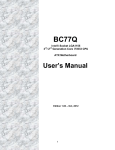
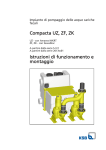
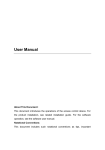
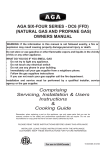


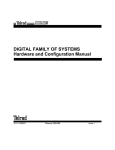

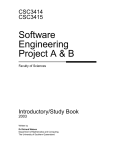

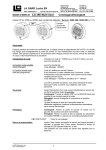
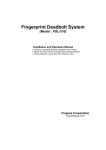
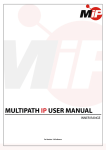
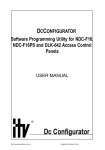
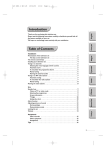
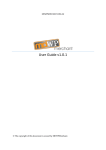
![[ENG] CE60-3 GSM Software ComCE v4-2](http://vs1.manualzilla.com/store/data/005829621_1-1503a18c5b086c34f94e34b38a52b968-150x150.png)

